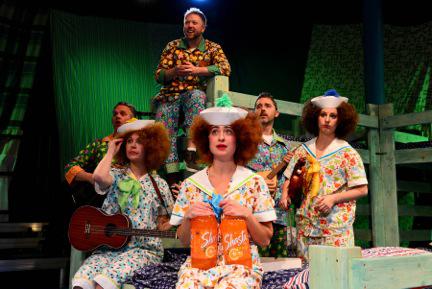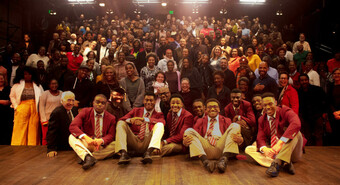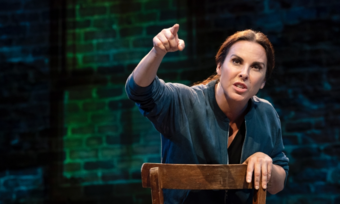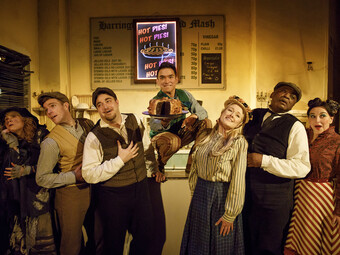Duration and the Avant-garde Part 2
The Tactics of Real Time
What is avant-garde theatre today? It’s easy enough to look back on last year’s vanguard, but how can we define the movement we are in the midst of? In her series, Kate Kremer explores the question of the new avant-garde.
Annie Baker’s The Flick had just won the Susan Smith Blackburn Prize and was on the brink of receiving an Obie and the Pulitzer when the frustration of some audience members prompted Playwrights Horizons artistic director Tim Sanford to pen a letter of explanation to the company’s subscribers.
What so raised the ire of some audiences (and what awed and excited others) was partly the length of the play (three hours or so) and partly the pace at which it unfolded—its insistence on the momentousness of the uneventful and a hyper-realistic depiction of the pauses, gaps, and hesitancies of actual speech. Hardly what one might consider an instance of “durational theatre,” many of The Flick’s audiences found it unendurable—and made a break for it at the interval.
When I saw Lisa D’Amour’s Airline Highway in January at Steppenwolf, a few of the patrons behind me expressed a similar frustration, though in this case it stemmed from surfeit rather than spareness, simultaneity rather than silence. D’Amour’s rich and complex portrait of the denizens of a down-and-out New Orleans motel is deeply invested in rendering the overlapping, symphonic quality of speech among people at a party. Her attention to interruptions and shifts in focus, to moments of fragmentation and unification, and to the immense dynamism of people in combination produces a play that pushes out to the edges of the frame, that locates as much of its energy at the margins—in clutter, in minutiae, in apparently insignificant conversations and minor characters—as it does at the narrative center. The structure resonates with the play’s exploration of social marginalization. Formally and thematically, Airline Highway posits the instability and contingency of “center” and “periphery,” suggesting they are questions of where we cut the frame.
So what’s the relationship between duration and realism? Why does realness onstage feel long, and why does duration seem to elicit from us a more real and empathetic response? Perhaps it has to do with the way that experiencing duration onstage reminds us of time’s imperatives—imperatives that are strictly naturalistic, actual, and imminent. It gives us a window into the dramatic tension that underlies the act of living, that is, of the conflict between our infinite desires and time’s finiteness.
Although not explicitly durational, The Flick—which opened Off-Broadway in May—and Airline Highway—which opened on Broadway in April—engage in a durational project of rendering “real time” onstage. In refusing to accommodate certain dramatic fantasies of fluent, successive speakers and well-mannered pauses, Baker and D’Amour realize more world-like worlds than are often seen onstage, i.e. worlds that are textured, layered and messy, intensely rich, not rounded. Their plays feel durational not because they are long but because they insist on the primacy of characters and place above symmetry, moment above event. In refusing either to stretch time or to shrink it, they suggest that the time their characters occupy has the same texture as our own. Theirs, like ours, is an impolitic time, a crude and even a cruel one in its disregard for what we’d like it to do. It’s a time that demands attention and respect—for itself and the people who live in it.
While the realistic sense of duration in Baker’s and D’Amour’s plays can engender greater empathy on the part of audiences for their characters, for Sean Graney—founding artistic director of The Hypocrites and adapter/director of their twelve-hour All Our Tragic—duration is one among many tactics that can be used to break down the barriers among audience members and between audience and performers. It’s a means of heightening an audience’s awareness of the act of attending theatre—of sharing, with strangers, a particular space and time.
I saw The Hypocrites’ All Our Tragic in September 2014 (the updated remount opens in Chicago in June). Graney’s epic adaptation of the thirty-two surviving Greek tragedies is designed to function like a modern festival of Dionysus, with frequent opportunities for food, drink, and conversation.
When I spoke to him last fall via Skype, Graney discussed the importance of not relying on an event’s duration. “My job,” he noted, “was to sculpt a twelve-hour event. So I was dramaturgically studying the needs of people stuck in a room for twelve hours like a dramaturg would study character.” The processes of writing and directing are consequently intertwined: “When I sit down to write, I am aware of the audience, of the tempo, how long we can go without a joke, how long they’ve been sitting, if this thing is too gruesome too early.” Graney is also aware of a certain circular illogic of theatregoing, which can make duration interesting simply because of the investment of time that it demands. But Graney is not interested in theatre as toughness. He’s interested in how inconvenience and difficulty can be the catalysts of a more real communication.
To that end, the three hours of meal and conversation time built into All Our Tragic are crucial to the play’s design. For although The Hypocrites do hope to elicit a different kind of attention from their audiences by asking for a more prolonged commitment, they are not interested in making them suffer. The durational aspect of their work, then, is less about endurance than it is about graciousness, about the radical hospitality of a company of actors that persists in giving us their energy, wit, and inventiveness over the course of an entire day, and the corresponding receptivity that that hospitality inspires in audiences. The sharing of fatigue among actors and audience, like the sharing of food, becomes its own source of interest and intimacy—and at last, also, elation.

Graney’s stagings of Mikado, Pirates of Penzance, and HMS Pinafore (performed this past winter in repertory), show a similar attention to the potent, delicate relationship between hospitality and inconvenience. Audiences for the three shows were seated on the floor and low circular benches in the playing area, and were required to scoot aside whenever actors indicated to them that they needed to enter the space. The physical challenge presented by asking audience and performers to occupy the same space created a need for a shared language and gave audiences the opportunity to experience the time of the performance more like the performers do: spontaneously, in motion, from many angles, with risk and access to the sense of touch. It gave physical form to the conversation already taking place between audience and actors by realizing it, making it more easily seen and felt.
So what’s the relationship between duration and realism? Why does realness onstage feel long, and why does duration seem to elicit from us a more real and empathetic response?
Perhaps it has to do with the way that experiencing duration onstage reminds us of time’s imperatives—imperatives that are strictly naturalistic, actual, and imminent. It gives us a window into the dramatic tension that underlies the act of living, that is, of the conflict between our infinite desires and time’s finiteness. Durational theatre can give us the opportunity to feel time not simply as antagonist, but as architecture, an environment that houses at the same time that it contains us. Which is a reminder of our mortality, obviously, but which is also a sign of the house we share—the only true theatre of insight and connection.








Comments
The article is just the start of the conversation—we want to know what you think about this subject, too! HowlRound is a space for knowledge-sharing, and we welcome spirited, thoughtful, and on-topic dialogue. Find our full comments policy here
This stuff was done in the 1960s. Altman used it on film. The problem is if you do not have an inner necessity or threat in place early on the audience loses interest. Three hours of a play without a life or death push towards something is patron torture. At least I find it that way. I enjoyed Lisa D'Amour's play "Detroit" because she structured it beautifully. A real threat comes close to the beginning and you sense that a terrible storm is going to overtake the stage and change people forever.